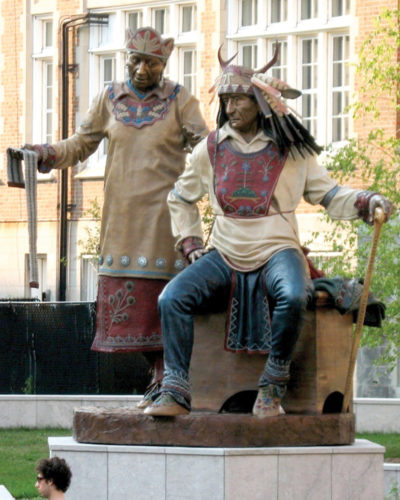Dave McGary was more than an artist. He was a master storyteller, spinning profound yarns in the language of wire and clay, fire and metal. And monumental sculptures proved to be his epic tales.
The large public pieces McGary created contain remarkable power. It’s not just their size, although that’s certainly a factor. They are a force that must be reckoned with, connecting with passersby, provoking thought and encouraging dialogue. Sculpture occupies three dimensions and that is never more apparent than when they are freed from the confines of gallery and museum. The bold installations pack an emotional wallop, conveying as they do, the unquenchable human spirit on such a grand scale.
McGary’s first monument, “The Founding of Santa Fe” resides in a park in the heart of that historic town. His engineering marvel, the horses of “Free Spirits at Noisy Water,” can be seen leaping and galloping across meadows larger than a football field in Ruidoso Downs, New Mexico. “Touch the Clouds,” a 10-ton likeness of a Miniconjou chief who fought alongside Crazy Horse at the Battle of Little Big Horn, was originally standing as a powerful sentinel outside the Houston Astrodome before being moved to the University of Central Oklahoma.
The three Chief Washakie monuments, sculptures that meant so to McGary, can be found in the Statuary Hall of the U.S Capitol, the Wyoming State Capitol and the Joint Shoshone and Arapaho Complex in Fort Washakie. The “Battle of Two Hearts” is a vivid portrayal of Chief Washakie astride a leaping horse at the University of Wyoming. McGary’s final monument, “Emergence of the Chief,” is at Concordia University in Montreal, Canada. It’s known as a “healing piece” because the college sits on Mohawk land and the 24-foot tall sculpture was the first acknowledgement of that fact.
The big bronzes are distinctly McGary’s work. You’ll immediately recognize the intoxicating blend of patina and vibrant color, the rich attention to detail, the anatomical accuracy and the life-like alertness found in his smaller pieces. Only the technique is even more complex. He had to cast numerous pieces, welding them together over a stainless steel structure for support and strength. Often components were pre-fabricated and then assembled on site. Despite the obstacles, it was a challenge he very much enjoyed.
“I love the monuments that I do at universities and in public places because it draws people in,” said McGary. “They’re like, ‘Wow!’ They look at the detail or the color. Then as they learn the story, it educates them as to what this person was about or what their culture was about. That is what is exciting to me.”
McGary said that eventually he wanted to be a teacher. Despite the fact that his years were cut tragically short, it was a goal he accomplished. And through his work, he continues to teach.
Get updates about our next exhibitions
We will process the personal data you have supplied in accordance with our privacy policy.







